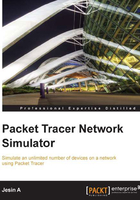
Cisco devices and Packet Tracer devices
Selecting Switches or Routers from the device-type selection box lists both Cisco devices and some devices labeled Generic. These are custom Packet Tracer devices running on Cisco IOS, but the slots that hold the modules are different.
Routers
A router provides connectivity between two logical networks. Every router in Packet Tracer can be switched on or off by using the provided power button.
The power switch is required to make a device simulate its real counterpart. Modules can be added or removed only after powering off the device. If the running configuration is not saved, power cycling a device will make it lose its configuration.
The following routers are available in Packet Tracer:
- Cisco 1841: This is an Integrated Service Router (ISR) having two Fast Ethernet ports, two slots for High Speed WAN Interface Cards (HWICs), and one slot for Advanced Integration Module (AIM)
- Cisco 1941: This is similar to the previous model but runs on Cisco IOS Version 15. It has two ports that operate at Gigabit Ethernet speeds.
- Cisco 2620XM: This is a multiservice router with one Fast Ethernet port, two slots for WAN Interface cards, and one slot for AIM.
- Cisco 2621XM: This is similar to the previous model, except that this router has two Fast Ethernet ports.
- Cisco 2811: This ISR comes with two Fast Ethernet ports, four WIC slots, and a dual slot for AIM.
- Cisco 2901: This router has two Gigabit Ethernet ports, four WIC slots, and two Digital Signal Processor (DSP) slots. This router uses Cisco IOS Version 15.
- Cisco 2911: This router has three Gigabit Ethernet ports and all the other features of the previous router. It runs on IOS Version 15.
- Generic Router-PT: This is a custom router running on Cisco IOS. It contains 10 slots and has separate modules with a naming convention beginning with PT.
Switches
A switch, also called a multiport bridge, connects more than two end devices together. Each switch port is a collision domain. The following switches are available in Packet Tracer:
- Cisco 2950-24: This managed switch comes with 24 Fast Ethernet ports.
- Cisco 2950T-24: This switch is a member of the Catalyst 2590 Intelligent Switch family and has two Gigabit Ethernet ports in addition to the 24 Fast Ethernet ports.
- Cisco 2960-24TT: This is another 24 port switch; the previous switch has Gigabit Interface Converter (GBIC) for Gigabit Ethernet ports, whereas this switch has Small Form-factor Pluggable (SFP) modules for the same. Note that this is a difference only on real switches, it has no impact on Packet Tracer.
- Cisco 3560-24PS: This switch is different from the others because it is a layer 3 switch that can be used to perform routing in addition to switching. The PS suffix implies support for Power over Ethernet (PoE), which can be used to power up IP phones without using power adapters.
- Bridge PT: This is a device used to segment a network and it has only two ports (which is why it is a bridge; if it had more, it'd be called a switch).
- Generic Switch PT: This is a Packet-Tracer-designed switch running on Cisco IOS. This is the only customizable switch with 10 slots and several modules.
Like the generic router, the switch section also includes a generic switch with 10 slots that can be customized with the required modules. Except for the generic switch, other Cisco model switches cannot be customized and do not have a power switch. This is because that is how real switches of the same models are designed.
Other devices
Packet Tracer has more than just Cisco routers and switches, which we'll see in this section. These devices do not have any configuration options and work out of the box.
- Hub PT: This network hub was the oldest way to connect multiple end devices together. It still exists in Packet Tracer so that you can simulate and learn about network storms and broadcasts. This Packet Tracer device has 10 slots.
- Repeater PT: This device is used to boost the signal on a wire when the distance between two points is high. We'll be using it in Chapter 5, Navigating and Modifying the Physical Workspace; this device has two slots.
- Coaxial Splitter PT: This is used to split a single coaxial connector into two. It has three coaxial ports and cannot be customized in any way.